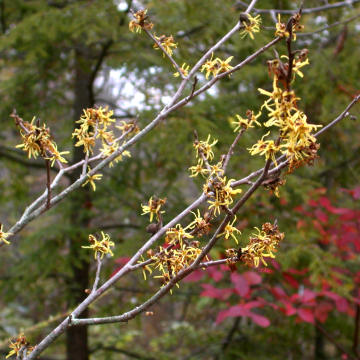

Hamamelis virginiana - (image 1 of 7)
Taxonomy
Family: Hamamelidaceae
Habitat
Rich woods, wooded slopes, ravine slopes. Pine barrens and wooded dunes.
Associates
Woody associates include Acer saccharum, Betula papyrifera, Cornus florida, Diervilla lonicera, Fagus grandifolia, Ostrya virginiana..
Distribution
Most of the eastern half of the US.
Morphology
Small, many stemmed tree, often leaning. Leaves deciduous, alternate, simple, irregularly oval, the margins wavy-crenate; veins straight, parallel, ascending, widely spaced, 5-7 per side. Buds without scales. Bark smooth, gray-brown, mottled. Flowers pale yellow with 4 strap-like petals, in clusters of 3 in the leaf axils, fragrant. Fruit a 2-parted capsule, fuzzy yellow-brown when mature, containing 2 glossy black seeds. The fruits take at least a year to mature.
Notes
Flowers early September to late December
Wetland indicator: Facultative upland
Fall color sometimes a good yellow. The flowers are wonderfully fragrant but the degree to which they smell varies from tree to tree and also on the time of year. The flowers seem to be most fragrant when they first open. The seeds are ejected forcefully from the capsules, making the cut stems somewhat of a hazard for floral arrangements. Selections have been made for trees that drop their leaves before flowering.
Bibliography
Dirr, Michael A. 1998. Manual of Woody Landscape Plants:
Their Identification, Ornamental Characteristics, Culture, Propagation and Uses.
5th ed. Champaign, Illinois: Stipes Publishing L.L.C.
Farrar, J. L. 1995. Trees of the Northern United States and Canada.
Ames, Iowa: Iowa State University Press
Swink, F. and G. Wilhelm. 1994. Plants of the Chicago Region.
Indiana Academy of Science. The Morton Arboretum. Lisle, Illinois.
|
Michael Hough © 2005 |